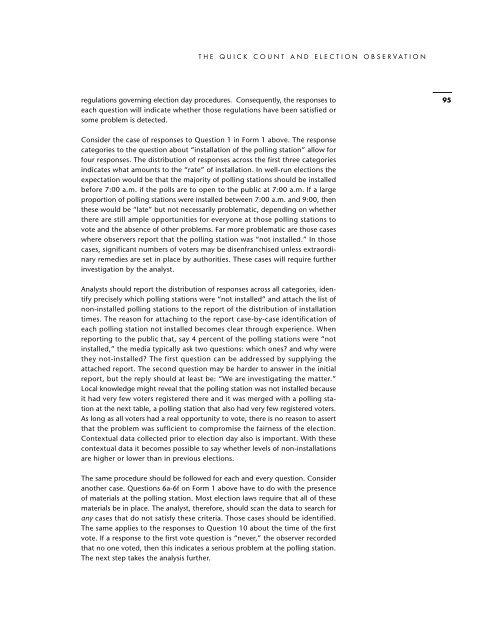The Quick Count and Election Observation
The Quick Count and Election Observation
The Quick Count and Election Observation
Create successful ePaper yourself
Turn your PDF publications into a flip-book with our unique Google optimized e-Paper software.
THE QUICK COUNT AND ELECTION OBSERVATION<br />
regulations governing election day procedures. Consequently, the responses to<br />
each question will indicate whether those regulations have been satisfied or<br />
some problem is detected.<br />
95<br />
Consider the case of responses to Question 1 in Form 1 above. <strong>The</strong> response<br />
categories to the question about “installation of the polling station” allow for<br />
four responses. <strong>The</strong> distribution of responses across the first three categories<br />
indicates what amounts to the “rate” of installation. In well-run elections the<br />
expectation would be that the majority of polling stations should be installed<br />
before 7:00 a.m. if the polls are to open to the public at 7:00 a.m. If a large<br />
proportion of polling stations were installed between 7:00 a.m. <strong>and</strong> 9:00, then<br />
these would be “late” but not necessarily problematic, depending on whether<br />
there are still ample opportunities for everyone at those polling stations to<br />
vote <strong>and</strong> the absence of other problems. Far more problematic are those cases<br />
where observers report that the polling station was “not installed.” In those<br />
cases, significant numbers of voters may be disenfranchised unless extraordinary<br />
remedies are set in place by authorities. <strong>The</strong>se cases will require further<br />
investigation by the analyst.<br />
Analysts should report the distribution of responses across all categories, identify<br />
precisely which polling stations were “not installed” <strong>and</strong> attach the list of<br />
non-installed polling stations to the report of the distribution of installation<br />
times. <strong>The</strong> reason for attaching to the report case-by-case identification of<br />
each polling station not installed becomes clear through experience. When<br />
reporting to the public that, say 4 percent of the polling stations were “not<br />
installed,” the media typically ask two questions: which ones? <strong>and</strong> why were<br />
they not-installed? <strong>The</strong> first question can be addressed by supplying the<br />
attached report. <strong>The</strong> second question may be harder to answer in the initial<br />
report, but the reply should at least be: “We are investigating the matter.”<br />
Local knowledge might reveal that the polling station was not installed because<br />
it had very few voters registered there <strong>and</strong> it was merged with a polling station<br />
at the next table, a polling station that also had very few registered voters.<br />
As long as all voters had a real opportunity to vote, there is no reason to assert<br />
that the problem was sufficient to compromise the fairness of the election.<br />
Contextual data collected prior to election day also is important. With these<br />
contextual data it becomes possible to say whether levels of non-installations<br />
are higher or lower than in previous elections.<br />
<strong>The</strong> same procedure should be followed for each <strong>and</strong> every question. Consider<br />
another case. Questions 6a-6f on Form 1 above have to do with the presence<br />
of materials at the polling station. Most election laws require that all of these<br />
materials be in place. <strong>The</strong> analyst, therefore, should scan the data to search for<br />
any cases that do not satisfy these criteria. Those cases should be identified.<br />
<strong>The</strong> same applies to the responses to Question 10 about the time of the first<br />
vote. If a response to the first vote question is “never,” the observer recorded<br />
that no one voted, then this indicates a serious problem at the polling station.<br />
<strong>The</strong> next step takes the analysis further.


